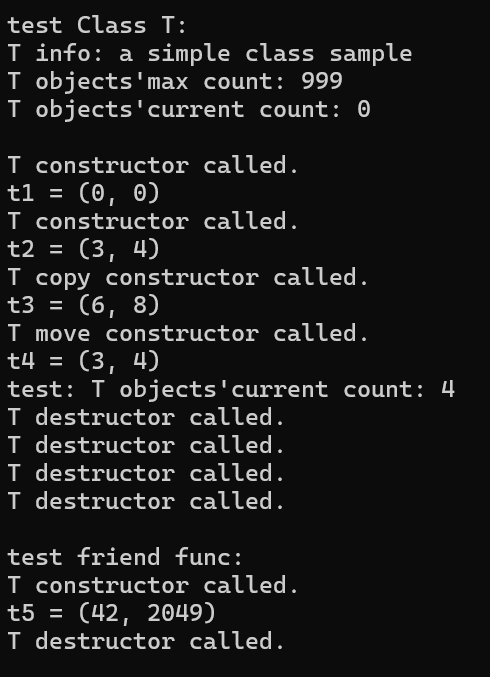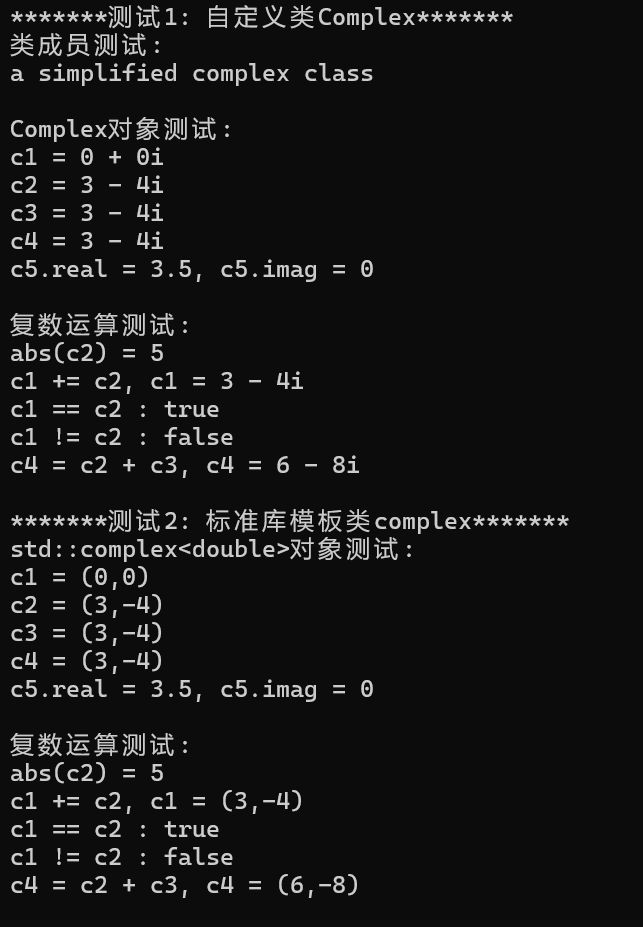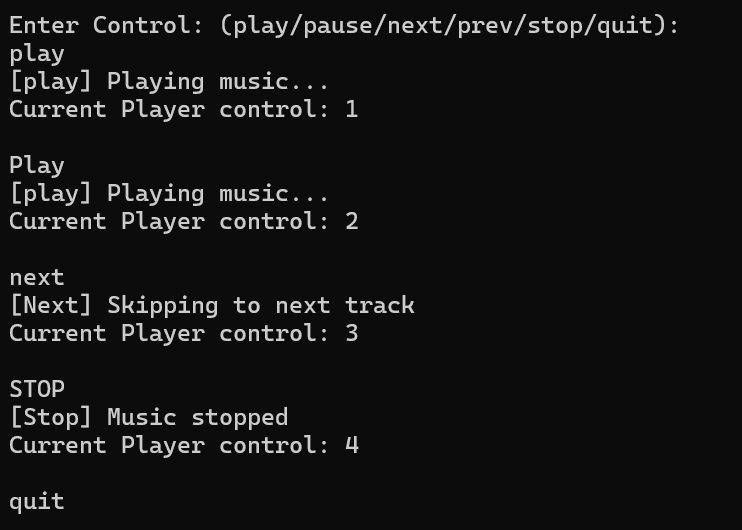实验二
实验任务一
T.h源码
#pragma once #include <string> class T { public: T(int x = 0, int y = 0); T(const T &t); T(T &&t); ~T(); void adjust(int ratio); void display() const; private: int m1, m2; public: static int get_cnt(); public: static const std::string doc; static const int max_cnt; private: static int cnt; friend void func(); }; void func();
T.cpp源码
#include "T.h" #include <iostream> #include <string> const std::string T::doc{"a simple class sample"}; const int T::max_cnt = 999; int T::cnt = 0; int T::get_cnt() { return cnt; } T::T(int x, int y): m1{x}, m2{y} { ++cnt; std::cout << "T constructor called.\n"; } T::T(const T &t): m1{t.m1}, m2{t.m2} { ++cnt; std::cout << "T copy constructor called.\n"; } T::T(T &&t): m1{t.m1}, m2{t.m2} { ++cnt; std::cout << "T move constructor called.\n"; } T::~T() { --cnt; std::cout << "T destructor called.\n"; } void T::adjust(int ratio) { m1 *= ratio; m2 *= ratio; } void T::display() const { std::cout << "(" << m1 << ", " << m2 << ")" ; } void func() { T t5(42); t5.m2 = 2049; std::cout << "t5 = "; t5.display(); std::cout << '\n'; }
task1.cpp源码
#include "T.h" #include <iostream> void test_T(); int main() { std::cout << "test Class T: \n"; test_T(); std::cout << "\ntest friend func: \n"; func(); } void test_T() { using std::cout; using std::endl; cout << "T info: " << T::doc << endl; cout << "T objects'max count: " << T::max_cnt << endl; cout << "T objects'current count: " << T::get_cnt() << endl << endl; T t1; cout << "t1 = "; t1.display(); cout << endl; T t2(3, 4); cout << "t2 = "; t2.display(); cout << endl; T t3(t2); t3.adjust(2); cout << "t3 = "; t3.display(); cout << endl; T t4(std::move(t2)); cout << "t4 = "; t4.display(); cout << endl; cout << "test: T objects'current count: " << T::get_cnt() << endl; }
运行结果截图

问题回答
问题1:
YES,T.h中类内的友元声明不会将func暴露到全局作用域,但此处编译器没有报错,这是Dev-C++对友元声明的宽松处理。
问题2:
(1)普通构造函数:
功能:初始化T类对象,为成员变量赋初始值
调用时机:创建T对象时调用
(2)复制构造函数:
功能:用已存在的T类对象,初始化新的T类对象
调用时机:用一个T对象初始化另一个T对象时调用
(3)移动构造函数:
功能:用右值引用的T对象初始化新对象,同时递增计数
调用时机:用右值初始化T对象时调用
(4)析构函数:
功能:递减对象计数,释放对象资源
调用时机:T对象生命周期结束时调用
问题3:
在Dev-C++中可以编译运行,但在其他编译器终不可以,因为类的静态成员必须在类外的全局作用域单独定义,如果剪切到末尾,会出 现“重复定义”的问题。
实验任务二:
Complex.h源码:
#pragma once #include <string> class Complex { public: static const std::string doc; Complex(double real = 0.0, double imag = 0.0); Complex(const Complex& other); double get_real() const; double get_imag() const; void add(const Complex& other); friend void output(const Complex& c); friend double abs(const Complex& c); friend Complex add(const Complex& c1, const Complex& c2); friend bool is_equal(const Complex& c1, const Complex& c2); friend bool is_not_equal(const Complex& c1, const Complex& c2); private: double real_; double imag_; };
Complex.cpp源码:
#include "Complex.h" #include <iostream> #include <cmath> const std::string Complex::doc = "a simplified complex class"; Complex::Complex(double real, double imag) : real_(real), imag_(imag) {} Complex::Complex(const Complex& other) : real_(other.real_), imag_(other.imag_) {} double Complex::get_real() const { return real_; } double Complex::get_imag() const { return imag_; } void Complex::add(const Complex& other) { real_ += other.real_; imag_ += other.imag_; } void output(const Complex& c) { if (c.imag_ >= 0) { std::cout << c.real_ << " + " << c.imag_ << "i"; } else { std::cout << c.real_ << " - " << -c.imag_ << "i"; } } double abs(const Complex& c) { return std::sqrt(c.real_ * c.real_ + c.imag_ * c.imag_); } Complex add(const Complex& c1, const Complex& c2) { return Complex(c1.real_ + c2.real_, c1.imag_ + c2.imag_); } bool is_equal(const Complex& c1, const Complex& c2) { return (c1.real_ == c2.real_) && (c1.imag_ == c2.imag_); } bool is_not_equal(const Complex& c1, const Complex& c2) { return !is_equal(c1, c2); }
task2.cpp源码:
#include "Complex.h" #include <iostream> #include <iomanip> #include <complex> void test_Complex(); void test_std_complex(); int main() { std::cout << "*******测试1: 自定义类Complex*******\n"; test_Complex(); std::cout << "\n*******测试2: 标准库模板类complex*******\n"; test_std_complex(); } void test_Complex() { using std::cout; using std::endl; using std::boolalpha; cout << "类成员测试: " << endl; cout << Complex::doc << endl << endl; cout << "Complex对象测试: " << endl; Complex c1; Complex c2(3, -4); Complex c3(c2); Complex c4 = c2; const Complex c5(3.5); cout << "c1 = "; output(c1); cout << endl; cout << "c2 = "; output(c2); cout << endl; cout << "c3 = "; output(c3); cout << endl; cout << "c4 = "; output(c4); cout << endl; cout << "c5.real = " << c5.get_real() << ", c5.imag = " << c5.get_imag() << endl << endl; cout << "复数运算测试: " << endl; cout << "abs(c2) = " << abs(c2) << endl; c1.add(c2); cout << "c1 += c2, c1 = "; output(c1); cout << endl; cout << boolalpha; cout << "c1 == c2 : " << is_equal(c1, c2) << endl; cout << "c1 != c2 : " << is_not_equal(c1, c2) << endl; c4 = add(c2, c3); cout << "c4 = c2 + c3, c4 = "; output(c4); cout << endl; } void test_std_complex() { using std::cout; using std::endl; using std::boolalpha; cout << "std::complex<double>对象测试: " << endl; std::complex<double> c1; std::complex<double> c2(3, -4); std::complex<double> c3(c2); std::complex<double> c4 = c2; const std::complex<double> c5(3.5); cout << "c1 = " << c1 << endl; cout << "c2 = " << c2 << endl; cout << "c3 = " << c3 << endl; cout << "c4 = " << c4 << endl; cout << "c5.real = " << c5.real() << ", c5.imag = " << c5.imag() << endl << endl; cout << "复数运算测试: " << endl; cout << "abs(c2) = " << abs(c2) << endl; c1 += c2; cout << "c1 += c2, c1 = " << c1 << endl; cout << boolalpha; cout << "c1 == c2 : " << (c1 == c2)<< endl; cout << "c1 != c2 : " << (c1 != c2) << endl; c4 = c2 + c3; cout << "c4 = c2 + c3, c4 = " << c4 << endl; }
运行结果截图:

问题回答:
问题1:
标准库complex用法更简洁,通过运算符重载实现了更自然的语法,而自定义类需通过函数调用实现。
问题2:
2-1:需要。这些函数需要访问Complex的私有成员来完成输出、计算模长、相加等操作,因此必须声明为友元以突破访问权限限制。
2-2:否。标准库std::complex的abs是全局函数,通过complex的公有成员函数获取实部、虚部,无需设为友元。
2-3:当外部函数或者类需要访问当前类的私有成员,且无法通过公有接口间接实现时,可将其声明为友元。
问题3:
可以改成Complex(const Complex&) = delete,使其无法被调用。
实验任务三:
PlayerControl.h源码:
#pragma once #include <string> enum class ControlType {Play, Pause, Next, Prev, Stop, Unknown}; class PlayerControl { public: PlayerControl(); ControlType parse(const std::string& control_str); // 实现std::string --> ControlType转换 void execute(ControlType cmd) const; // 执行控制操作(以打印输出模拟) static int get_cnt(); private: static int total_cnt; };
PlayerControl.cpp源码:
#include "PlayerControl.h" #include <iostream> #include <algorithm> int PlayerControl::total_cnt = 0; PlayerControl::PlayerControl() {} ControlType PlayerControl::parse(const std::string& control_str) { std::string lower_str = control_str; std::transform(lower_str.begin(), lower_str.end(), lower_str.begin(), [](unsigned char c) { return std::tolower(c); }); if (lower_str == "play") { total_cnt++; return ControlType::Play; } else if (lower_str == "pause") { total_cnt++; return ControlType::Pause; } else if (lower_str == "next") { total_cnt++; return ControlType::Next; } else if (lower_str == "prev") { total_cnt++; return ControlType::Prev; } else if (lower_str == "stop") { total_cnt++; return ControlType::Stop; } else { total_cnt++; return ControlType::Unknown; } } void PlayerControl::execute(ControlType cmd) const { switch (cmd) { case ControlType::Play: std::cout << "[play] Playing music...\n"; break; case ControlType::Pause: std::cout << "[Pause] Music paused\n"; break; case ControlType::Next: std::cout << "[Next] Skipping to next track\n"; break; case ControlType::Prev: std::cout << "[Prev] Back to previous track\n"; break; case ControlType::Stop: std::cout << "[Stop] Music stopped\n"; break; default: std::cout << "[Error] unknown control\n"; break; } } int PlayerControl::get_cnt() { return total_cnt; }
task3.cpp源码:
#include "PlayerControl.h" #include <iostream> void test() { PlayerControl controller; std::string control_str; std::cout << "Enter Control: (play/pause/next/prev/stop/quit):\n"; while(std::cin >> control_str) { if(control_str == "quit") break; ControlType cmd = controller.parse(control_str); controller.execute(cmd); std::cout << "Current Player control: " << PlayerControl::get_cnt() << "\n\n"; } } int main() { test(); }
运行结果截图:

思考:
只需修改execute方法的输出内容,替换为带 emoji 的字符串即可。
实验任务四:
Fraction.h源码:
#pragma once #include <string> class Fraction { public: static const std::string doc; Fraction(int up, int down = 1); Fraction(const Fraction& other); int get_up() const; int get_down() const; Fraction negative() const; friend void output(const Fraction& f); friend Fraction add(const Fraction& f1, const Fraction& f2); friend Fraction sub(const Fraction& f1, const Fraction& f2); friend Fraction mul(const Fraction& f1, const Fraction& f2); friend Fraction div(const Fraction& f1, const Fraction& f2); private: int up_; int down_; void simplify(); static int gcd(int a, int b); };
Fraction.cpp源码:
#include "Fraction.h" #include <iostream> #include <stdexcept> const std::string Fraction::doc = "Fraction类 v 0.01版.\n目前仅支持分数对象的构造、输出、加/减/乘/除运算."; Fraction::Fraction(int up, int down) : up_(up), down_(down) { if (down == 0) { throw std::invalid_argument("分母不能为0"); } if (down_ < 0) { up_ = -up_; down_ = -down_; } simplify(); } Fraction::Fraction(const Fraction& other) : up_(other.up_), down_(other.down_) {} int Fraction::get_up() const { return up_; } int Fraction::get_down() const { return down_; } Fraction Fraction::negative() const { return Fraction(-up_, down_); } int Fraction::gcd(int a, int b) { a = std::abs(a); b = std::abs(b); while (b != 0) { int temp = b; b = a % b; a = temp; } return a; } void Fraction::simplify() { int common_divisor = gcd(up_, down_); up_ /= common_divisor; down_ /= common_divisor; } void output(const Fraction& f) { if (f.down_ == 1) { std::cout << f.up_; } else { std::cout << f.up_ << "/" << f.down_; } } Fraction add(const Fraction& f1, const Fraction& f2) { int new_up = f1.up_ * f2.down_ + f2.up_ * f1.down_; int new_down = f1.down_ * f2.down_; return Fraction(new_up, new_down); } Fraction sub(const Fraction& f1, const Fraction& f2) { int new_up = f1.up_ * f2.down_ - f2.up_ * f1.down_; int new_down = f1.down_ * f2.down_; return Fraction(new_up, new_down); } Fraction mul(const Fraction& f1, const Fraction& f2) { int new_up = f1.up_ * f2.up_; int new_down = f1.down_ * f2.down_; return Fraction(new_up, new_down); } Fraction div(const Fraction& f1, const Fraction& f2) { if (f2.up_ == 0) { throw std::invalid_argument("分母不能为0"); } int new_up = f1.up_ * f2.down_; int new_down = f1.down_ * f2.up_; return Fraction(new_up, new_down); }
task4.cpp源码:
#include "Fraction.h" #include <iostream> #include <stdexcept> void test1(); void test2(); int main() { std::cout << "测试1:Fraction类基础功能测试\n"; test1(); std::cout << "\n测试2:分母为0测试:\n"; test2(); } void test1() { using std::cout; using std::endl; cout << "Fraction类测试:" << endl; cout << Fraction::doc << endl << endl; Fraction f1(5); Fraction f2(3, -4), f3(-18, 12); Fraction f4(f3); cout << "f1 = "; output(f1); cout << endl; cout << "f2 = "; output(f2); cout << endl; cout << "f3 = "; output(f3); cout << endl; cout << "f4 = "; output(f4); cout << endl; const Fraction f5(f4.negative()); cout << "f5 = "; output(f5); cout << endl; cout << "f5.get_up() = " << f5.get_up() << ", f5.get_down() = " << f5.get_down() << endl; cout << "f1 + f2 = "; output(add(f1, f2)); cout << endl; cout << "f1 - f2 = "; output(sub(f1, f2)); cout << endl; cout << "f1 * f2 = "; output(mul(f1, f2)); cout << endl; cout << "f1 / f2 = "; output(div(f1, f2)); cout << endl; cout << "f4 + f5 = "; output(add(f4, f5)); cout << endl; } void test2() { using std::cout; using std::endl; Fraction f6(42, 55), f7(0, 3); cout << "f6 = "; output(f6); cout << endl; cout << "f7 = "; output(f7); cout << endl; try { cout << "f6 / f7 = "; output(div(f6, f7)); cout << endl; } catch (const std::invalid_argument& e) { cout << e.what() << endl; } }
运行结果截图:

问题回答:
友元。
优势:可直接访问Fraction的私有成员,无需通过get_up()或者get_down()间接获取,简化代码逻辑;
缺点:一定程度上破坏了类的封装性,需谨慎控制友元的使用范围。



 浙公网安备 33010602011771号
浙公网安备 33010602011771号